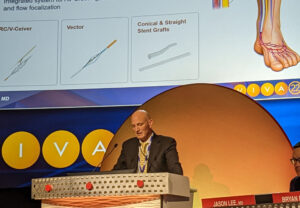
Six-month results from the PROMISE II trial of the LimFlow deep-vein arterialization system showed an overall amputation-free survival of 66%—“well above” the primary endpoint target of 54%, chief investigator Daniel Clair, MD, told the 2022 Vascular Interventional Advances (VIVA) meeting (Oct. 31–Nov. 3) in Las Vegas.
The PROMISE II research team further demonstrated a limb salvage rate of 76% and overall survival rate of 87% in a group of patients that Clair, professor and chair in the Department of Vascular Surgery at Vanderbilt University in Nashville, Tennessee, described as “the sickest group of patients ever enrolled in a lower-extremity pivotal trial.”
PROMISE II was conducted at 20 sites in the U.S. with more than 100 enrollees, all of whom were classed as having Rutherford 5 and 6 levels of peripheral arterial disease (PAD)—commonly referred to as a “no-option” group of end-stage chronic limb-threatening ischemia (CLTI) patients.
Clair reported a technical success rate of 99% across “a wide range of investigators from all different specialties” using the LimFlow transcatheter arterialization system among a patient population he described as predominately older, male, diabetic and who bore the “typical group of comorbidities,” with around 20% on dialysis.
There was a large difference in outcomes for dialysis vs. non-dialysis patients—driven primarily by an increased mortality in the dialysis group, Clair noted. “The primary reason this group did not meet [the target] is really overall survival,” he told VIVA 2022. “This is obviously a very sick group of patients. If you have end-stage renal disease, and in addition, reach the point where your limb is not salvageable, there is probably major changes that we need to do in order to improve their overall survival.”
Six-month results also showed a wound healing rate of 75% (either healed or healing), Clair said, rising to almost 80% at the 12-month mark, according to independent core lab evaluation. Pain scores for this patient population, too, continue to decline over time alongside “a significant improvement in their quality of life,” he added.
Additionally, Clair reported an improvement in the patient group’s Rutherford classification at the six-month point, telling VIVA that almost 20% were categorized as either Rutherford 0 or 1. Out to a year, he continued, “at least preliminarily,” nearly 60% were recorded as Rutherford 0.
Concluding, Clair said: “The PROMISE II study met its endpoint with a very reliable amputation-free survival. Transcatheter arterialization is safe and effective. These results are very much in line with what we saw in the PROMISE I outcomes, and from my viewpoint, now we have to find a new name for this group of patients.”












